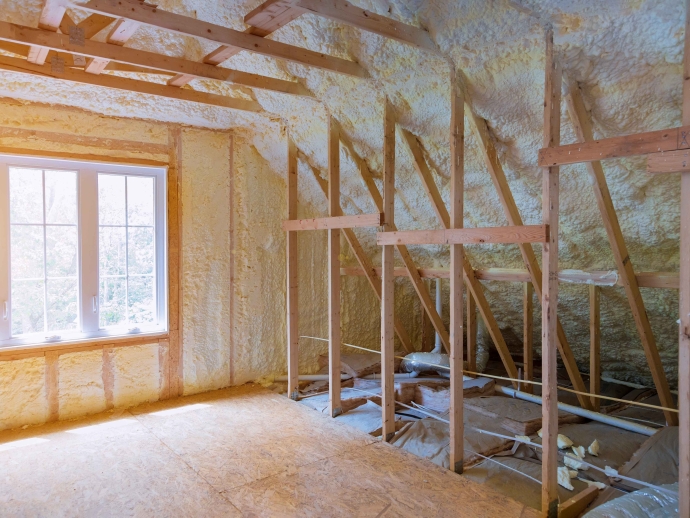Battling High Energy Bills? Discover Which Insulation Type—Spray Foam, Fiberglass, or Cellulose—Can

Homeowners in the Dallas-Fort Worth (DFW) area often face high energy bills, especially during the sweltering summers and chilly winters. One of the most effective ways to combat these rising costs is by investing in quality insulation. The type of insulation you choose can significantly impact your energy efficiency, comfort, and overall utility expenses. Among the most popular insulation options are spray foam, fiberglass, and cellulose. This article will explore each type's benefits and drawbacks to help you determine which insulation can save you the most money.
Understanding Insulation Types
1. Spray Foam Insulation
Spray foam insulation is a modern solution made from a mixture of isocyanate and polyol resin. When applied as a liquid, it expands into a foam that fills gaps and creates an airtight seal. There are two types of spray foam:
-
Open-cell spray foam: This type is less dense and provides good sound absorption but has a lower R-value (approximately R-3.5 to R-4 per inch).
-
Closed-cell spray foam: Denser and more rigid, closed-cell foam offers a higher R-value (approximately R-6.5 to R-7 per inch) along with moisture resistance.
Advantages:
-
Excellent air sealing properties that reduce energy loss.
-
High R-value for superior thermal resistance.
-
Acts as a moisture barrier, preventing water infiltration.
-
Long-lasting durability (up to 80–100 years).
Disadvantages:
-
Higher initial cost (around $1.50 to $3 per square foot for closed-cell).
-
Requires professional installation due to specialized equipment.
2. Fiberglass Insulation
Fiberglass insulation is one of the most traditional insulation materials available. It comes in batts or loose-fill forms and is made from tiny glass fibers. The R-value for fiberglass typically ranges from R-2.9 to R-3.8 per inch.
Advantages:
-
Cost-effective option (averaging $0.10 to $0.50 per square foot).
-
Quick and easy installation.
-
Non-combustible and resistant to moisture when properly installed.
Disadvantages:
-
Lower R-value compared to spray foam.
-
Can allow air leaks if not installed correctly.
-
May settle over time, reducing effectiveness.
3. Cellulose Insulation
Cellulose insulation is an eco-friendly option made primarily from recycled paper products treated with fire retardants. It is typically installed as loose-fill material and has an R-value ranging from R-3.1 to R-3.8 per inch.
Advantages:
-
Environmentally friendly, made from 100% recycled materials.
-
Good sound dampening properties.
-
Effective at filling odd-shaped areas due to its loose-fill nature.
Disadvantages:
-
Higher initial cost compared to fiberglass.
-
Can settle over time, leading to reduced effectiveness.
-
Requires professional installation for optimal performance.
Cost Considerations
When evaluating insulation options for your DFW home, consider both the initial investment and long-term savings on energy bills:
Spray Foam
While spray foam insulation has a higher upfront cost, its superior insulating properties can lead to significant long-term savings on energy bills. The excellent air sealing capabilities ensure that conditioned air stays inside your home, reducing the workload on your HVAC system.
Fiberglass
Fiberglass insulation is generally the most budget-friendly option initially; however, it may lead to higher energy costs if not installed correctly or if it settles over time. While it provides decent thermal resistance, its lower R-value compared to spray foam means that homeowners might spend more on heating and cooling in the long run.
Cellulose
Cellulose insulation falls between fiberglass and spray foam in terms of cost but offers substantial long-term savings due to its effective insulating properties. Its eco-friendly nature may also appeal to environmentally conscious homeowners looking for sustainable solutions.
Energy Efficiency Comparison
When comparing these three types of insulation regarding energy efficiency, several factors come into play:
-
R-Value: The R-value measures thermal resistance; higher values indicate better insulating capabilities. Spray foam generally provides the highest R-values, making it ideal for energy efficiency in extreme climates.
-
Air Sealing: Spray foam excels in air sealing capabilities due to its ability to expand and fill gaps thoroughly, which helps reduce air leakage significantly. Proper air sealing can prevent conditioned air from escaping your home, leading to lower energy bills.
-
Moisture Resistance: Closed-cell spray foam acts as a moisture barrier, making it ideal for areas prone to humidity or water exposure. In contrast, cellulose can absorb moisture if not treated properly, while fiberglass does not provide effective moisture resistance unless combined with other barriers.
Conclusion
Battling high energy bills in your DFW home requires careful consideration of insulation options such as spray foam, fiberglass, and cellulose. Each material offers distinct advantages and disadvantages that can impact your home's comfort level and energy costs.
-
If you prioritize energy efficiency and are willing to invest more upfront, spray foam insulation may be the best choice for your home.
-
For those looking for an economical solution with decent performance, fiberglass insulation remains a solid option.
-
If sustainability is your primary concern and you want an eco-friendly material that offers good performance, consider cellulose insulation.
Ultimately, consulting with a professional insulation contractor can provide personalized recommendations based on your specific needs and home characteristics. With the right insulation in place, you can enjoy a comfortable living environment year-round while reducing energy costs in your DFW residence. Investing in quality insulation not only enhances your home's efficiency but also contributes positively to the environment by minimizing your carbon footprint.

